#northern crab spider
Text

Found a little northern crab spider hiding in my peach foxgloves waiting to pounce on some bees with its venomous bite.
#bane folk#northern crab spider#mecaphesa asperata#crab spider#flower spider#venomous spider#foxgloves#foxglove#digitalis#digitalis purpurea dalmatian peach#peach foxglove#poisonous plants#toxic plants#poison path flora#poison path fauna#poison path
58 notes
·
View notes
Text
Tiny Little Crab Spiders are Powerful Hunters
Hidden
Northern crab spiders (Mecaphesa asperata) are interesting, and rather devious little hunters. Unlike a lot of spiders, they don’t build webs, but instead they are ambush hunters. They hide on plants that are flowering and wait for pollenators to come along for a meal. Then they leap out and bite the prey. These little spiders are quite small, but they are strong and fast and can often…

View On WordPress
#ambush hunters#crab spider photographs#crab spiders#Florida crab spiders#hidden crab spiders#hidden spiders#macro photographs#macro photography#northern crab spider#spider photographs#spider photography#spiders#springtime crab spiders#tiny spiders#white spiders
0 notes
Photo


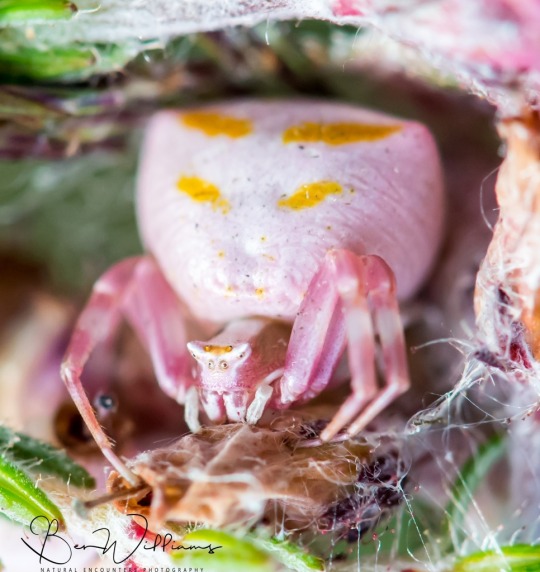
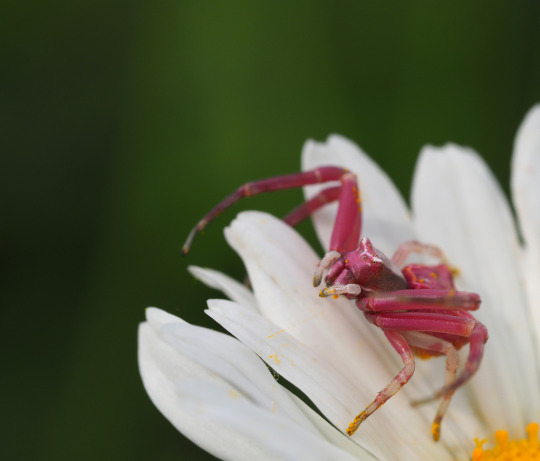

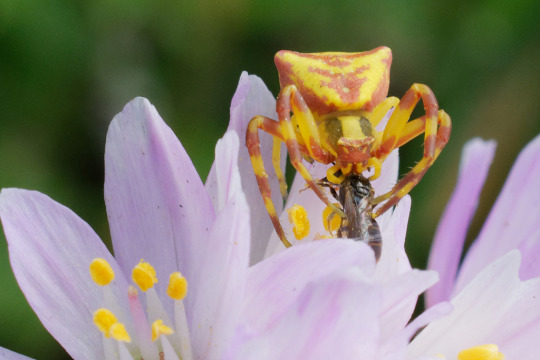


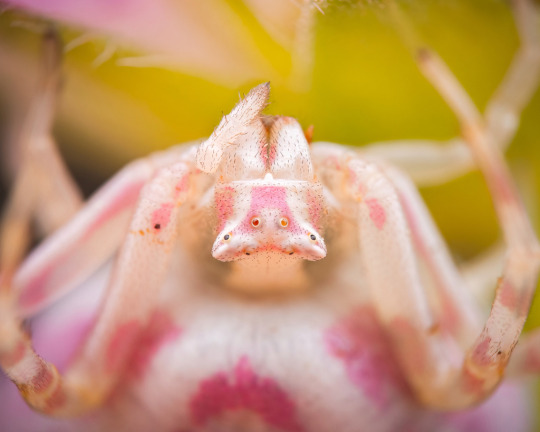

Pink crab spider, Thomisus onustus, Thomisidae
Despite the common name, this species exhibits a wide range of coloration including pink, white, yellow, green, brown, or a combination of any of those. Like other flower crab spiders, they are able to change their color over a matter of days to more closely match their environment. Found in Eurasia and northern Africa.
Photo 1 by paulf84, 2 by wildchroma, 3 by sonic7730, 4 by ffigon, 5 by marie-ruel, 6 by marketaz, 7 by dbenvenuti, 8 by mammal, 9 by alexis_orion, and 10 by talgar-t64
#animals#curators on tumblr#bugs#arachnids#insects#spider#crab spider#pink crab spider#bee#bug death#predation#one nice bug#camouflage
5K notes
·
View notes
Text
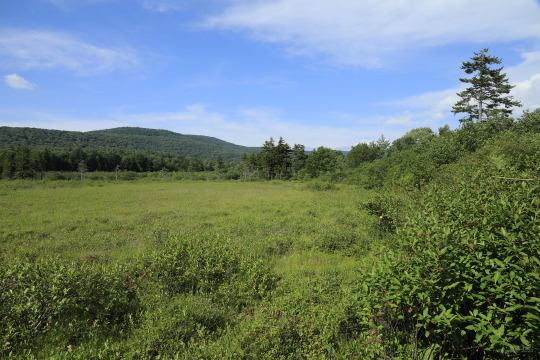
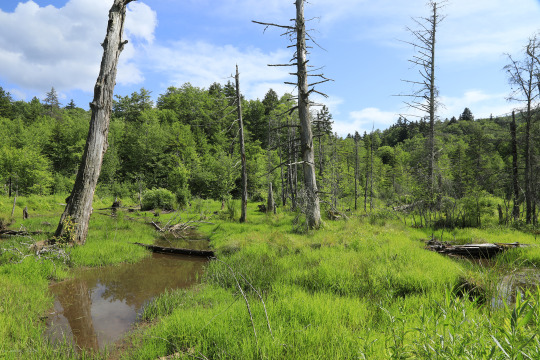
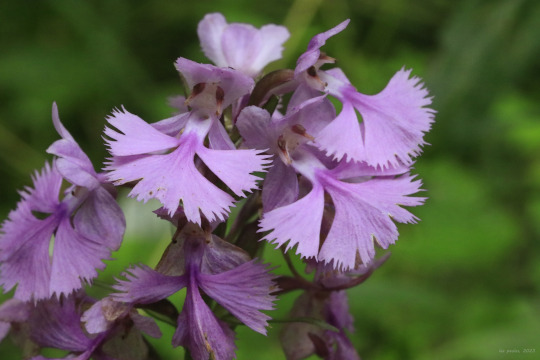
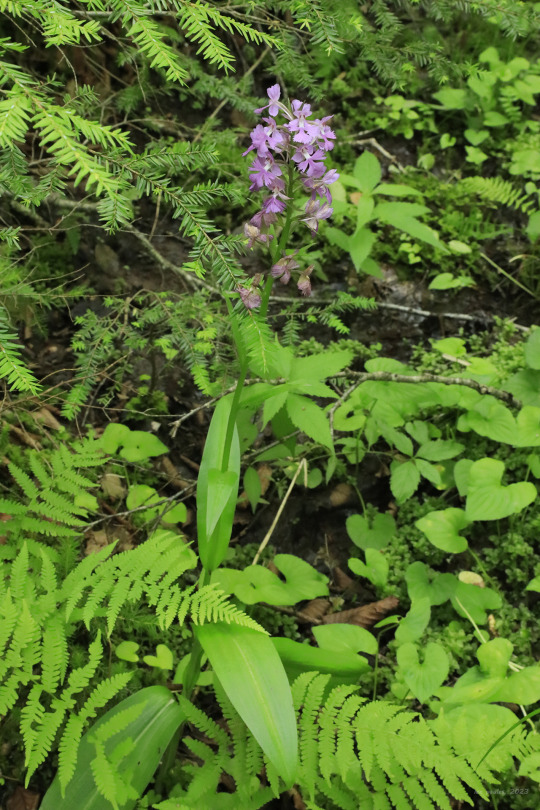

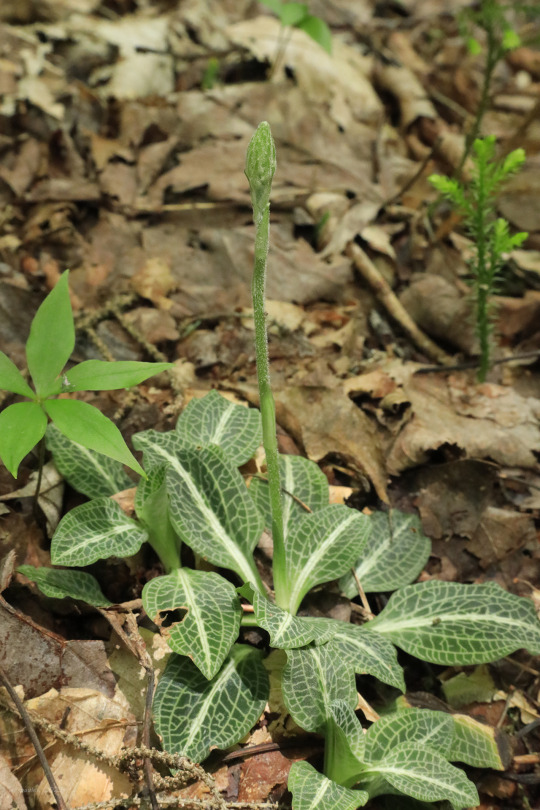
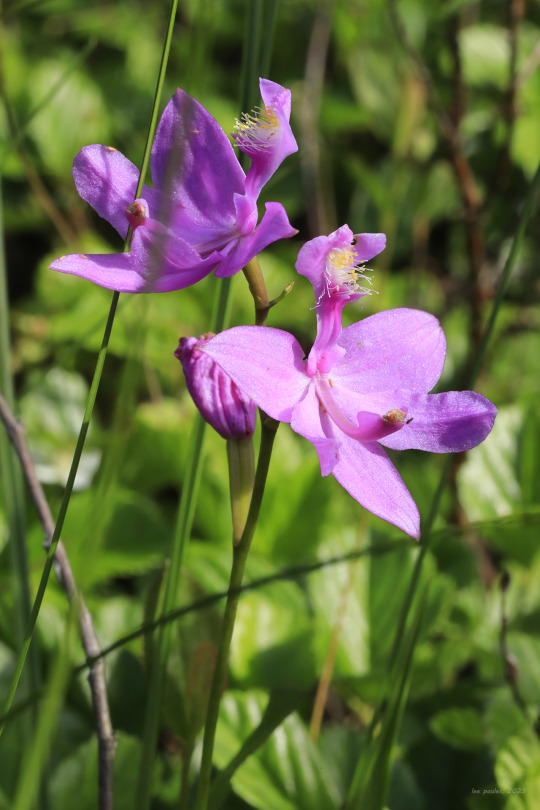
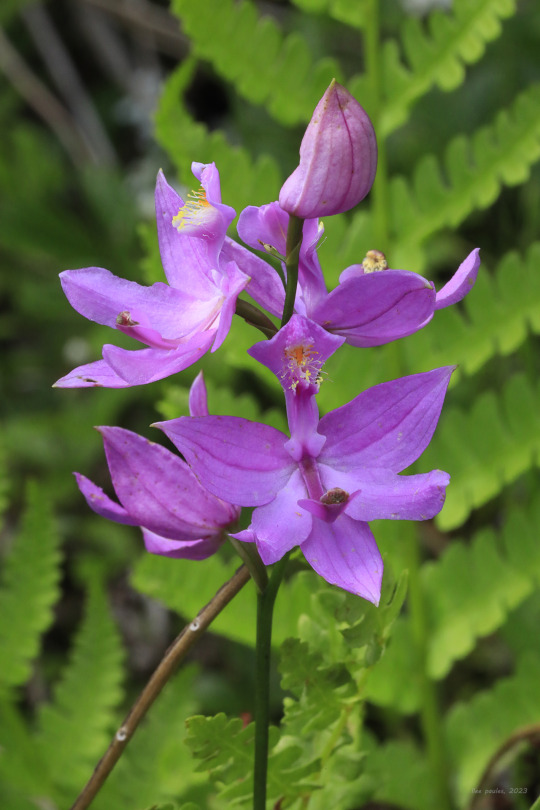



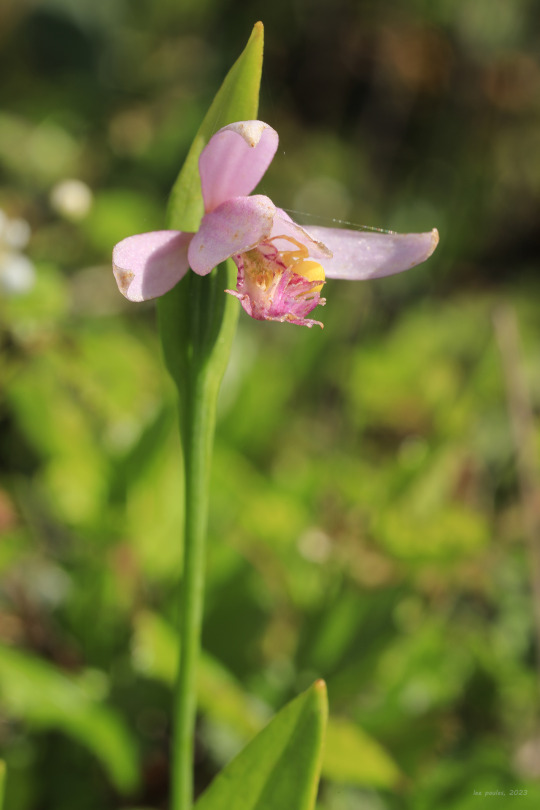

Part 1: Early Summer Wildflower Palooza, Cranberry Glade. It's orchid week at Cranberry Glades! Ok - the event may not be quite as exciting as Shark Week on Discovery, but plant nerds such as me experience something approaching tingly nipples at the prospect of getting up close and personal with grass pinks and snakemouths. A sampling of the many orchids now in bloom . . .
From top: greater purple fringed orchid (Platanthera grandiflora), a tall, leafy-stemmed beauty with clustered, intricately-fringed lavender flowers; downy rattlesnake plantain (Goodyera pubescens), a common terrestrial orchid of eastern woods with a striking, reticulated pattern in its leaves (this one is getting ready to bloom); the flamboyantly-beautiful tuberous grass pink (Calopogon tuberosus var. tuberosus), whose nectarless flowers deceptively imitate the magenta color of those of other bog plants, such as meadow phlox (following post), to draw pollinators; a ragged fringed orchid (Platanthera lacera), also known as green fringed orchid, whose fragile, frilly green-white flowers are hard to spot in the bog underbrush; the dainty rose pogonia (Pogonia ophioglossoides), also known as snakemouth orchid, due the tooth-like protuberances on its lower lip (note the sneaky goldenrod crab spider (Misumena vatia) hiding in the flower in the second photo, waiting to pounce on an unsuspecting bee, the orchid's primary pollinator); and northern tubercled orchid (Platanthera flava), another orchid with green-white flowers that can be difficult to spot in the bog underbrush.
#appalachia#vandalia#west virginia#wildflowers#flora#allegheny mountains#monongahela national forest#cranberry glades#wetlands#bog#sphagnum bog#summer#orchids#highland scenic highway#wv route 150#greater purple fringed orchid#downy rattlesnake plantain#tuberous grass pink#ragged fringed orchid#green fringed orchid#rose pogonia#snakemouth orchid#northern tubercled orchid#goldenrod crab spider
110 notes
·
View notes
Text
Miracle Boxes - The True Generation
These are the second iteration of the Miracle Boxes, and the generation that lasted the longest, stretching out for several thousand years. The Miraculouses within these boxes are very similar to the generation before, save for many kwamis of the Mage Box being divided out among the other boxes of the world, and the Mage Box being hidden away as the Secret Box.
During this time kwamis were free to chose their own holders, and spent more time out in the world than in their Miracle Boxes. Guardians were protectors of kwamis in their dormant state, but were not wardens of them. Kwamis would often travel far from their boxes and across the world, acting as protectors where they felt they were needed.
---
Secret Box - Hidden
Panda
Crow
Unicorn
Successor Box - Central Asia
Ladybug
Black Cat
Qilin
Frog
Bee
Butterfly
Fox
Peacock
Swan
Turtle
Island Box - Oceania
Wolf
Platypus
Pterosaur
Tuatara
Binturong
Blackbuck
Coral
Kangaroo
Komodo
Thylacine
Zodiac Box - East Asia
Dragon
Cobra
Rabbit
Dog
Goat
Horse
Monkey
Mouse
Ox
Pig
Rooster
Tiger
Perennial Box - North America
Thunderbird
Bear
Beaver
Cougar
Deer
Goose
Otter
Owl
Rattlesnake
Raven
Salmon
Woodpecker
Central Box - Central America
Firefly
Raccoon
Feathered Serpent
Spider
Axolotl
Bison
Coyote
Eagle
Falcon
Parrot
Shark
Tropical Box - South America
Grim
Snail
Crocodile
Dolphin
Flamingo
Jaguar
Jellyfish
Llama
Locust
Moth
Jungle Box - Southern Africa
Dinosaur
Penguin
Elephant
Gorilla
Okapi
Jackal
Ray
Rhinoceros
Squirrel
Zebra
Desert Box - Northern Africa
Griffin
Dragonfly
Camel
Chameleon
Cheetah
Giraffe
Hippopotamus
Hyena
Ostrich
Secretarybird
Constellation Box - Southern Europe
Kelpie
Aurochs
Ant
Crab
Dove
Gecko
Hedgehog
Ibex
Lion
Mouflon
Scorpion
Seahorse
Arctic Box - Northern Europe
Phoenix
Lynx
Moose
Narwhal
Octopus
Polar Bear
Seal
Sheep
Stoat
Wolverine
Mountain Box - South Asia
Yeti
Red Panda
Bat
Elk
Pangolin
Quail
Scarab
Snow Leopard
Tortoise
Vulture
---
The True Generation came to an end with the start of the Miraculous War, with the rise of what became known as the Order of the Guardians.
---
The Mage Generation of Miracle Boxes
The Order Generation of Miracle Boxes [TBA]
#kwamis#kwami oc#kwami#oc kwami#vitaa#plagg#tikki#shii#miraculous headcanon#miraculous headcanons#ml headcanons#my headcanons#miracle box#miraculous boxes#not too much different in terms of who's in what box#but there will be a lot of changes with the order generation
13 notes
·
View notes
Text
🧜♂️Send in a number + Character and I'll draw them as a mermaid based on that creature🧜♀️
Part 2: Friend suggested a list of more "unconventional" options
Alligator Gar
Amazon river dolphin (aka pink river dolphin)
American Lobster
Arapaima Gigas
Atlantic Wolffish
Barreleye
Bastard Sturgeon
Beluga Whale
Black Crappie
Blue Glaucus
Blue Whale
Cassiopeia Jellyfish
Chambered Nautilus
Cheerleader Crab (aka pom-pom crab)
Chromodoris
Coelacanth
Cuttlefish
Dolphin
Electric Eel
Fried-Egg Jellyfish
Giant Cuttlefish
Giant Isopod
Goliath Tigerfish
Harp Seal
Hermit Crab
Immortal Jellyfish
Leopard Seal
Manta Ray
Mantis Shrimp
Moon Jellyfish
Narwhal
Nembrotha
Northern Pike
Ocean Sunfish
Orca
Pharaoh Cuttlefish
Red-Bellied Piranha
Rainbow Trout
San Francisco Piranha
Sea Angel
Sea Bunny
Snakehead Fish
Spanish Shawl Nudibranch
Spanish Dancer Nudibranch
Spider Crab
Spotfin Frogfish
Spotted Ratfish
Stingray
Terrible Claw Lobster
Yeti Crab
15 notes
·
View notes
Text

Bestiary of Thedas
From bird to insect, fish to land animal. Every creature mentioned in Dragon Age, blighted and non-blighted, spirits and demon, created and possessed creatures alike are listed along with their breeds, subspecies, or variations.
If you want a more specific list, check out the post for Real World Animals in Thedas
Updated: 2023/11
Amphibian
Frog
Salamander
Toad
Horned Toad
Poison Toad
Birds
Albatross
Black-capped Songbird
Bluebird
Budgerigar
Bunting
Buzzard
Canary
Crow
Dove
Duck
Mallard Duck
Eagle
Falcon
Finch
Goose
Grouse
Gull
Hawk
Kingfisher
Lark
Magpie
Merlin
Mockingbird
Nightingale
Owl
Parakeet
Parrot
Partridge
Peafowl
Pheasant
Pigeon
Ptarmigan
Quail
Raven
Robin
Rock Darter - Native to the Anderfels, an insect eating bird.
Seagull
Simir - A bird hunted in Tevinter for the magical properties in their feathers.
Sparrow
Swan
Swift
Turkey
Vulture
Bald-necked Vulture
Fish and Marine Creatures
Blind Tetrava
Bluefin
Carp
Cetus
Cod
Eel
Lamprey Eel
Jellyfish
Krone
Mackerel
Octopus
Raytooth
River Herring
Shark
Squid
Giant Squid
Trout
Whale
Bony Whale-Shark
Pilot Whale
Whitebait
Crustaceans and Shellfish
Clam
Crab
Giant Swamp Crab
Crayfish
Cuttlefish
Lobster
Mussel
Oyster
Prawns
Shrimp
Insects
Bee
Bumblebee
Honeybee
Beetle
Cave Beetle
Death Watch Beetle
Dung Beetle
Glow Worm
Roof Beetle
Wood-burrowing Beetle
Butterfly
Cricket
Dragonfly
Firefly
Flea
Fly
Blue Flies
Giant Spider
Giant Poisonous Spider
Giant Spiderling
Poison Spider
Gnat
Hornet
Ladybug
Leeches
Locust
Maggot
Scorpion
Silkworms
Slugs
Snail
Spider
Wasp
Worm
Earthworm
Poison Worm
Tapeworm
Mammals
Badger
Honey Badger
Bat
Giant Bats
Bear
Black Bear
Brown Bear
Cavern Bear
Great Bear
Large Bear
Boar
Bogfisher
Bronto
Cat
Cattle
Bull
Cow
Ox
Qalab
Chicken
Cockerel
Cretahl
Dathrasi
Deer
Red Deer
Stag
Dog
Coursing Hound
Ferelden Shepard
Hunting Dog
Mabari
Pug
Rat Terrier
Sheepdog
Wild Dog
Wofun Hound
Donkey
Druffalo
Elephant
Elk
Ermine
Fennec
Ferret
Fox
Gazelle
Ghast
Giant
Goat
Ayesleigh gulabi goats
Mountain Goat
Griffon
Gurn
Halla
Hamster
Hare
Hart
Bercilian Sure-Foot
Greater Frostback Elk
Pride of Arlathan
Red Hart
Royal Sixteen
Tirashan Swiftwind
White Hart
Wild Hart
Horse
Amaranthine Charger
Anderfel
Anderfel Courser
Asaarash
Avvar Mixed Draft
Dalish All-Bred
Fereldan Forder
Free Marches Ranger
Frostback Mountain Horse
Green Dales Feral
Imperial Warmblood
Inquisition Barded Charger
Oath-Bound Steed
Orlesian Courser
Taslin Strider
Hyena
Jackal
Jackrabbit
Lion
Great Lion
Red Lion
Lynx
Marmot
Marten
Mole
Monkey
Moose
Mountain Lion
Mouse
Chip Mouse
Mule
Nug
Nuggalope
Avvar War Nug
Battle Nug
Greater Nuggalope
Greater Mountain Nuggalope
Gwaren Land-Hammer
Knuckled Thunderer
Tiddles Majoris
Otter
Pig
Rabbit
Raccoon
Ram
August Ram
Rat
Giant Rat
Sheep
Snoufleur
Spotted Cat
Spotted Hunting Cat
Squirrel
Tiger
Tusket
Voles
Weasel
Wolf
Black Wolf
Crag Wolf
Great Wolf
Wolverine
Reptiles
Adder
Death Adder
Basilisks
Cobra
Crocodile
Deepstalker
Deepstalker Matriarch - largest deepstalker
Deepstalker Leader - always male, second largest deepstalker
Deepstalker Runner
Dracolisk
Abyssal Hang-Tooth
Basking Longma
Blue River Bane
Desert Lightning
Hunter Shade Dracolisk
Mountain Dracolisk
Primal-Trained Longma
Sharp-Tail
Dragon
Abyssal High Dragon
Fereldan Frostback
Gamordan
Stormrider
Greater Minstral
Guardian of Mythal
Highland Ravager
Hivernal
Hunterhorn Shrikes
Kaltenzahn
Northern Hunter
Sandy Howler
Stonejaw
Vinsomer
Dragonling
Drake
Great Dragon
Guardian Serpent
Gurgut
Lurker
Phoenix
Quillback
Sand Stalker - a small vermin-like creature similar to deepstalkers
Sand Stalker Spitter
Sand Stalker Leader - larger than common sand stalkers
Varghest
Viper
Wyvern
Snowy Wyvern
Created Creatures
Golem
Varterral
Blighted Creatures
Bereskarn
Blight Owl
Blight Wolf
Blighted Werewolf
Bloodcrow
Corrupted Spider
Corrupted Spider Queen
Darkspawn
Archdemon
Broodmothers
Children
Emissary
Genlock
Hurlock
Ogre
Shriek
Darkspawn Magisters (Named and known)
The Architect
Corypheus
Dragon Thrall
Ghoul
Created Creatures
Golem
Varterral
Demons and Spirits
Spirits
Choice
Command
Compassion
Faith
Hope
Justice
Knowledge
Perseverance
Valor
Wisdom
Memory
Wisp
Wraith
Demons
Desire
Despair
Envy
Fear
Hunger
Pride
Rage
Remorse
Shade
Sloth
Terror
Vengeance
Possessed/Magical Creatures
Abomination
Arcane Horror
Ash Wraith
Corpse
Devouring Corpse
Devouring Skeleton
Enraged Corpse
Fanged Skeleton
Shambling Corpse
Shambling Skeleton
Skeleton
Skeleton Archer
Skeleton Mage
Walking Corpse
Dryads
Harvester
Revenant
Rock Wraith
Ancient Rock Wraith
Sylvans
Vampire
Werewolf
Wood Nymphs
Undefined
Glowing Slime
Firesprite
Wandering Hills
Sources
Dragon Age Origins + DLCs
Dragon Age Awakening
Dragon Age 2 + DLC
Dragon Age Inquisition + DLC
Dragon Age Inquisition Multiplayer
Dragon Age: Last Court
Dragon Age: Official Cookbook: Tastes of Thedas
Dragon Age Tabletop Core Rulebook
Dragon Age Tabletop Blood of Ferelden
World of Thedas Vol 1
World of Thedas Vol 2
Dragon Age: Asunder
Dragon Age: Masked Empire
Dragon Age: Last Flight
Dragon Age: Tevinter Nights
Short Story: The Riddle of Truth
Short Story: Varric
Dragon Age Origins
Armor: Clamshell Armor
Armor: Dalish Gloves
Codex: The Bow of the Golden Sun
Codex: Bronto
Codex: Deepstalker
Codex: The Frostback Mountains
Codex: Meditations and Odes to Bees
Codex: Nug
Codex: Rat
Codex: The Vaterral
Item: Fox's Pendant
Item: Golden Mirror
Item: Lamb Bone
Item: Micah/s Lucky Deer Foot
Item: Ox Bone
Item: Rat Poison
Item: Uncrushable Pigeon
Weapon: Cat Lady's Hobble-Stick
Dragon Age 2
Armor: Rat-Nibbled Gloves
Codex: Broken Dowsing Rods - No Refunds
Codex: Carta Bronto
Codex: Pride and Rider
Junk: Stuffed Parrot
Quest: Redblossom Special
Weapon: The Tiger's Tail
Last Court
The Acerbic Dowager
The Applewoods
The Arrival of the Divine
The Boastful Neighbor
The Cheery Baron
Choose your quarry
The Dowager Steps Forward
Enlightenment
Glass
Glassblowers' Anger
Graffiti
A Life of Toil
A Meeting with the Outlaw
A Plea for Sanctuary
River Herring
The Sealed Chantry
A Swift Stream
Sylvian Raid
An Unofficial Meeting
The Well-Read Pig-Farmer
You have cornered the bear
You have the hind in view
Dragon Age Inquisition Items and Codex
Codex: August Ram
Codex: Andruil's Messenger
Codex: Bear (Inquisition)
Codex: Constellation Tenebrium
Codex: Correspondence Interruptus
Codex: Crate of the Live Death Watch Beetles
Codex: Cretahl
Codex: Dirthamen: Keeper of Secrets
Codex: The Folly of General Not-Shertan
Codex: Ghilan'nain: Mother of the Halla
Codex: Hard in Hightown Chapter 15
Codex: A Horsemaster's Notes on Mounts
Codex: The Hunt of the Fell Wolf
Codex: Journal of Gurd Harofsen
Codex: The Lion of Orlais
Codex: Moldy Journal
Codex: A Nutty Affair
Codex: On Avvar Cuisine
Codex: The Perendale War
Codex: Ram
Codex: Scout Lace Harding
Codex: Surviving the Western Approach
Landmark: Crestwood: The Guide of Falon'Din
Note: Charred Note
Note: Sera's Cabinet of Wonder Whose it Was
Valuable: Carved Cricket Charm
Valuable: Cut Crystal Lion
Valuable: Eagle Feather Charm
Valuable: Falcon Crest
Valuable: Glass Fox
Valuable: Golden Ladybug Charm
Valuable: Grouse Feather Charm
Valuable: Raven Totem
Valuable: Silver Dragonfly Charm
Valuable: Vulture Feather Charm
Valuable: Wooden Mabari Figurine
Wartable Mission: A Present for Bianca
Wartable Mission: Smash
Want to support this blog? Check out my ko-fi?
#dragon age#fauns of thedas#da ttrpg#lore reference#writing reference#da writing reference#da worldbuilding#dragon age reference#fauna fridays#long post#creature: birds#creature: insect#creature: spider#creature: fish#creature: horse#creature: dragon#creature: hart#creature: nug
35 notes
·
View notes
Note
Hey there. So, as a personal side project, I might be making a fanmade region based on China, and so far I'm trying to flesh out the invertebrate side of things. Specifically, I'm going for ones that are native to or common there. So far, I have:
Silk moth (Bombyx mori and Antheraea pernyi) [Bug/Normal] When I was making these, I had no idea you did a Bug/Normal silk moth. Oops...
Chinese luna moth (Actias dubernardi) [Bug/Fairy]
Blue carpenter bee (Xylocopa caerulea) [Bug/Steel]
Chinese hourglass spider (Cyclocosmia ricketti) [Bug/Psychic]
Shanghai hairy crab (Eriocheir sinensis) [Water/Dark] Making this one pirate/thief themed due to being an invasive species. Also crab claws + pirate hook?
Hallucigenia [Rock/Psychic] A bit on the nose, but I'm fairly surprised the fossils were actually found on
Any ideas on what other arthropods (or invertebrates in general) I could add? Thanks.
Those are all fantastic ideas! My silk moth is actually bug/fairy, and either way you can't pass that up for a China-inspired region.
What comes to mind first for me would be a Chinese Mantis, possibly inspired by the mantis-style martial arts. You could even give it two forms based on northern vs southern style.
There's also the Chinese Golden Earth Tiger tarantula Cyriopagopus schmidti, a large burrowing species with gold and black coloration, tiger-like stripes on the abdomen, and a prominent white "beard". I read that it might have inspired the legend of the Tsuchigumo, which I used to make a Bug/Dragon pseudolegendary, but it's one of those concepts I'd love to see someone else's take on.
A caterpillar infected by Ophiocordyceps, though it might be cribbing too much from Paras and Parasect.
A polychaete worm (such as Phyllodoce citrina) stylized into a Chinese dragon.
A hammerhead worm (Bipalium spp)
6 notes
·
View notes
Text

May 13, 2022 - Black-tailed Whistler or Mangrove Golden Whistler (Pachycephala melanura)
Found in northern Australia and Papua New Guinea, these whistlers live in mangroves and nearby forests and scrub. Foraging in vegetation and only rarely on the ground, they eat invertebrates, including insects, spiders, and small crabs. They build thin cup-shaped nests from grass, rootlets, twigs, and spiderwebs where females lay two or three eggs. Both parents feed the chicks.
#black-tailed whistler#mangrove golden whistler#whistler#pachycephala melanura#bird#birds#illustration#art#water#birblr art
67 notes
·
View notes
Text

Ancardia's Unusual Animals--The Great Iceworm
Classification: Beast (mollusc)
Habitat: Arctic and Anctarctic seas, concentrated under consistent areas of sea ice.
The Great Iceworm is a gargantuan species of seaworm which until recent Ages was scarcely researched due to its difficult and remote habitat. The second largest of all of Ancardia’s invertebrates, the great iceworm spends its entire lifecycle in the icy waters of the two polar zones of Ancardia’s seas, depending upon the rich biomass of the oceans below and close to permanent sea ice. It is known to be particularly common in the very southernmost ranges of Sostuniland, where many tens of thousands of square miles of sea ice remain throughout the summer and the density of large calved icebergs remains high throughout the year, but they do also occur in significant populations under the northern ice cap to the far north of Tvearban’s coasts. Like many of the ocean’s largest creatures, it is docile to most other creatures, only feeding on the smallest of lifeforms in its environment. The majority of a great iceworm’s diet is krill mixed with larval crabs and fishes, supplemented by various somewhat larger invertebrates such as basket stars, polychaete worms, and sea spiders. Several species of large amphipods have evolved seemingly to live only on the dead tissue and parasites that afflict the great iceworm, and so you will seldom find one of these huge creatures swimming without an entourage of several dozen to several hundred palm-size red and gold primitive crustaceans.
While the worm itself is not particularly aggressive, it is possible to startle it which brings on the danger of such a huge animal responding by a defensive thrashing. Its mouthparts are relatively small, but still large enough for bites to be injurious to humanoids, and if directly attacked it will not hesitate to retaliate. Most of the danger from great iceworms comes from their boreholes in the sea ice layer in order to periodically breathe air, which are as wide as the worm’s body itself (usually 2 to 3 meters in diameter) and have been known to very lightly freeze over or have loose snow blow into them, creating a brittle thin area that is not immediately obvious as an environmental hazard. Dropping several meters into below-freezing water in such situations is almost always fatal even with assistance in escaping the frigid water, and so Sostunians living and working around sea ice often are careful to bring walking poles to test the areas along their route for hollow sounding ice and unusually-placed deep, loose snow.
Great iceworms are extremely large, and vary in size depending on their age and the density of food supply they have encountered so far. Most adults measure a minimum of 14 meters in length as either younger individuals or those in areas with less abundant plankton life, but can also reach astounding lengths of 25 or even 30 meters. The average length is closer to 20 meters, though as newly-hatched larvae they begin life as only about 5 centimeters in length. Great iceworms breed whenever they encounter abundant krill for longer than a few weeks at a time, and can breed multiple times in a year (though this is very rare), and will either seek out a mate or undergo parthenogenesis if a mate is nowhere to be found. Eggs are laid in masses on the underside of sea ice, in bundles of 20,000 to 40,000 at a time, though most will be picked off by various sea life before hatching. A larval great iceworm grows exponentially in its first year, usually reaching several meters very quickly. Before reaching adult size, juvenile great iceworms are subject to predation from a number of sharks, other large worms, seabirds and seals. Great iceworms are not known to die from old age, their population mainly being controlled by parasite numbers, predation on larva and eggs, and scarcity of food.
#ancardia#ancardian homebrew#bestiary#mixed media#creatures#animals#Ancient Domains of Mystery#ADOM#Dnd-like#Great Iceworm#giant worm#iceworm
4 notes
·
View notes
Text
June 28th, 2022

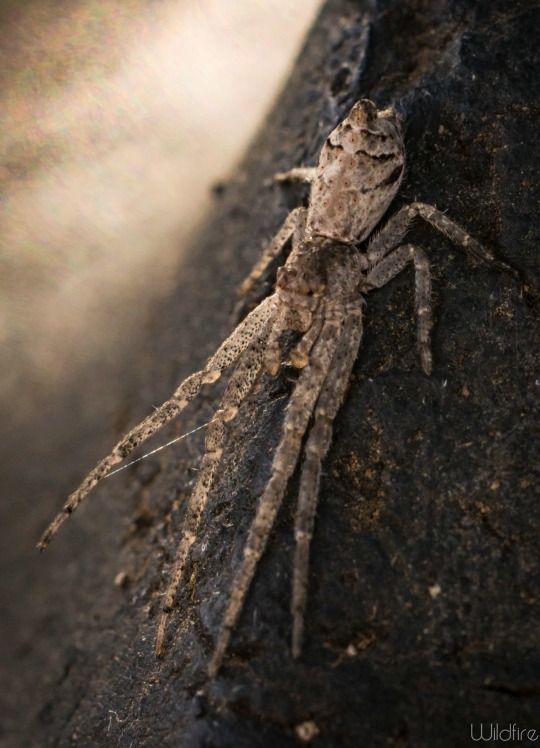
Tuberculated Crab Spider (Tmarus angulatus)
These odd-looking fellas are primarily found in southern Canada and the Northern United States, becoming rarer as you move towards the southwest. They are an uncommon sight, likely due to their small size—while females can reach up to 7 millimetres in length (excluding their long legs), males only reach around 5.
The tuberculated crab spider is an active predator, and does not spin webs like the majority of spiders. Instead, it waits on a twig or branch with its front two pairs of legs outstretched, allowing it to surge forward and grab its prey; with those long legs, it has quite a reach!
The crab spider family owes its name to its odd movement, and the tuberculated crab spider is no exception. It is laterigrade; it holds its front pairs of legs to the side, perpendicular to its body, allowing it to scuttle sideways like a crab.
15 notes
·
View notes
Text


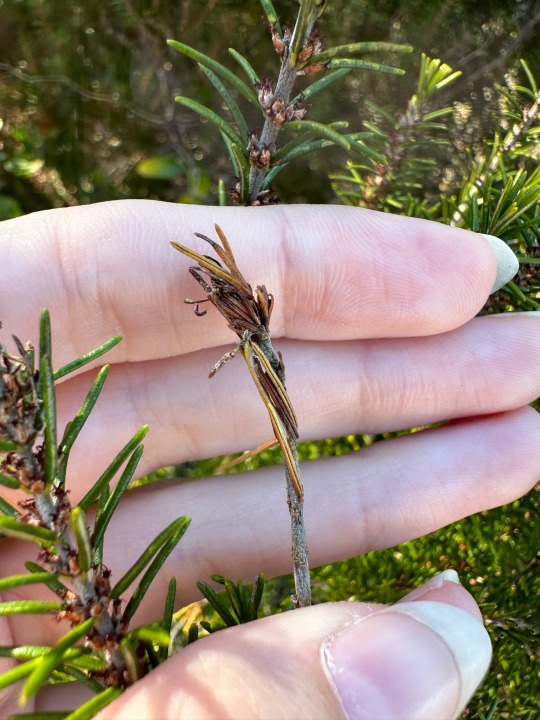



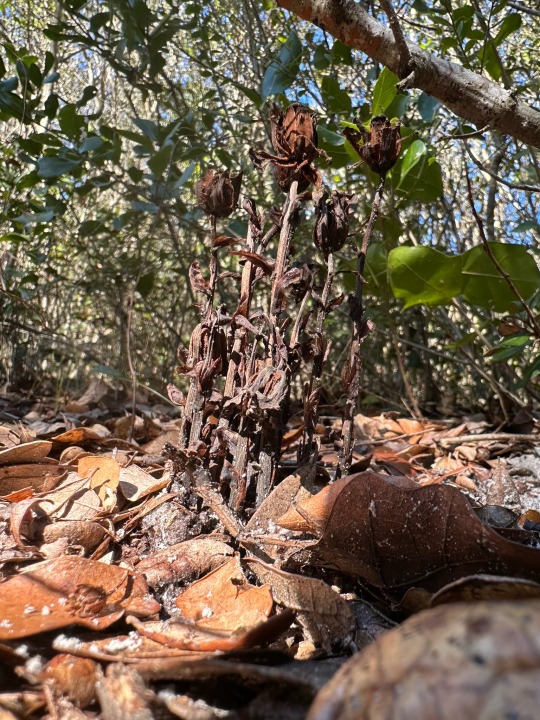


A few cool things I saw on my adventure in Volusia County on Thursday.
🕷
Very excited about the spring fishfly and that spider, which were both new species to me! The spider is either a Mecaphesa asperata (Northern crab spider) or a species that isn’t in any of my spider guides. Check out the pic with my hand to see a different part of the plant that spider was on—the spider seems perfectly adapted to just look like a dead section of the false rosemary!
🕷
Also pictured: earthstar fungus, a cactus Hidden Mickey, ghost pipes past their prime, a southern 2-striped walkingstick (Anisomorpha buprestoides), fluffy Garberia, a carpet of deer lichen that looks soft enough to take a nap in, and sunlight streaming through a leaf with impeccable TEXTURE 😍
🌲
🕷
🌸
🪲
🔍
#florida #bug #insect #spider #fungus #wetlands #earthstar #mushroom #macro #nature #naturelovers #outsideisfree #cactus #nature_brilliance #fiftyshades_of_nature #scarab #springfishfly @visitwestvolusia @countyofvolusia
0 notes
Text

@plethodon-uncia submitted: A friend! Maybe a crab spider? On a sword fern in northern california
Yep! Likely a goldenrod crab spider. I love her :)
175 notes
·
View notes
Text

mirror spider
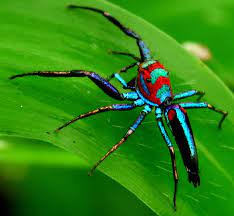
elegant golden jumping spider

crab spider

northern jewelled spider

1 note
·
View note
Text
Wild Coasts

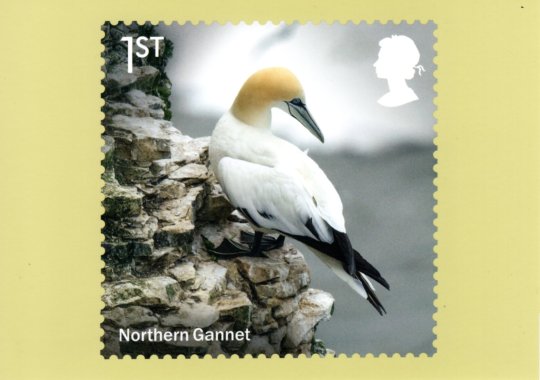
SG4542 - 1st, Northern Gannet
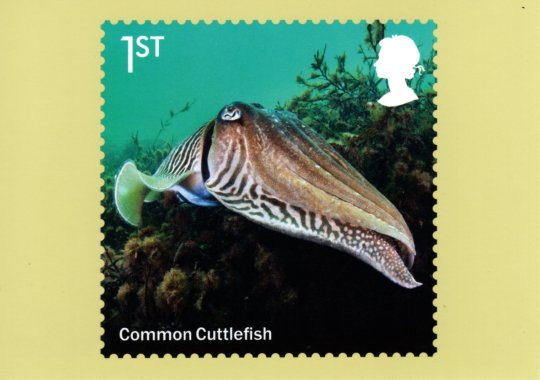
SG4543 - 1st, Common Cuttlefish

SG4544 - 1st, Grey Seal

SG4545 - 1st, Bottlenose Dolphin

SG4546 - 1st, Spiny Spider Crab
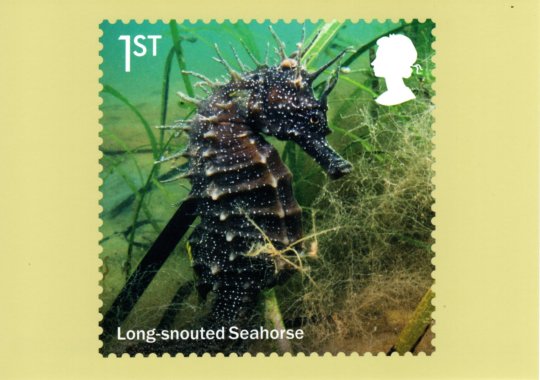
SG4547 - 1st, Long-snouted Seahorse
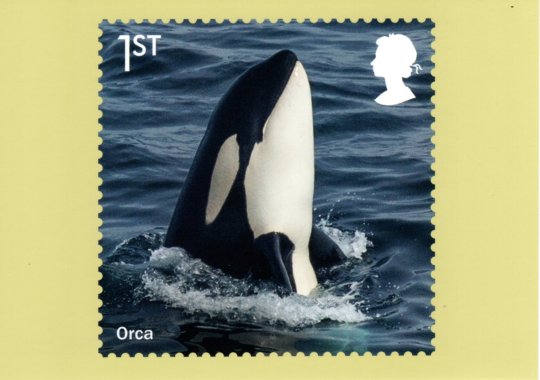
SG4548 - 1st, Orca

SG4549 - 1st, Fried-egg Anemone
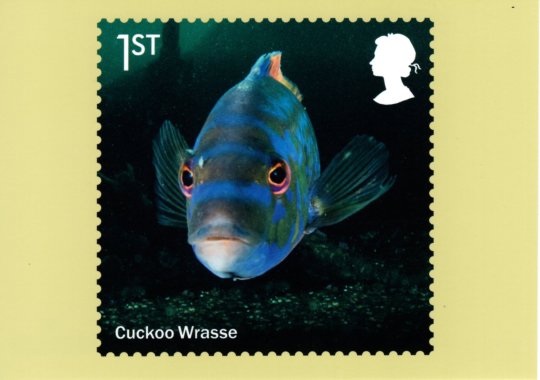
SG4550 - 1st, Cuckoo Wrasse

SG45451- 1st, Cold-water Coral Reef
0 notes
Text
The Northern Crab Spider is Amazing and Really Cool
The Northern Crab Spider is Amazing and Really Cool tells the author’s story of finding a tiny white crab spider on a flower. It then describes the difficulties encountered in trying to identify the species this spider and the reasons for the difficulty.
On the Flower’s Edge
Anyone who knows me or has read very many of these stopretty quickly comes to realize that I love spiders. Yes, I’m that girl who catches them inside my house and office and puts them back outside rather than stomping them. I’m not quite as crazy as some friends of mine in Australia who let them live inside their home, but I’m close. Back in the spring we had thistles…

View On WordPress
0 notes